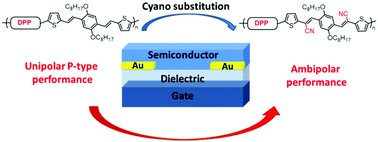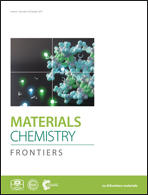Novel vinylene-bridged donor–acceptor copolymers: synthesis, characterization, properties and effect of cyano substitution†
Abstract
Two novel vinylene-bridged π-extended building blocks, (2E,2′E)-3,3′-(2,5-bis(octyloxy)-1,4-phenylene)bis(2-(5-bromothiophen-2-yl)acrylonitrile) (BOPACN) and 5,5′-((1E,1′E)-(2,5-bis(octyloxy)-1,4-phenylene)bis(ethene-1,2-diyl))bis(2-bromothiophene) (BOPA), were synthesized. They were further copolymerized with two diketopyrrolopyrrole (DPP) units possessing different alkyl side chains, and four donor–acceptor copolymers, namely PBOPACN-1, PBOPACN-2, PBOPA-1 and PBOPA-2, were synthesized. The optical, thermal, and electrochemical properties and field-effect properties of all copolymers were systematically investigated by theoretical calculations and experimental methods. Field-effect transistors based on these copolymers exhibited p-type charge transport characteristics in air. The performance implies that cyano substituents exert an important influence on semiconducting behaviours. Furthermore, 2D-GIXRD and theoretical calculations demonstrate that the presence of cyano substituents improves molecular planarity and generates highly-ordered molecular aggregates for PBOPACN-1 and PBOPACN-2.

- This article is part of the themed collection: Molecular Materials and Devices


 Please wait while we load your content...
Please wait while we load your content...